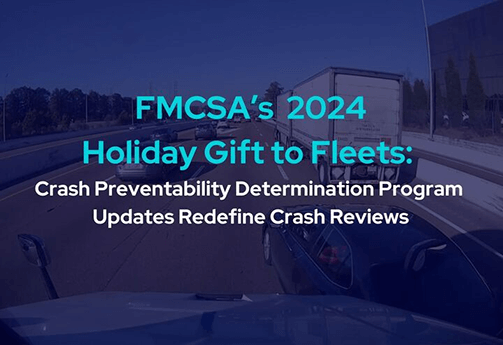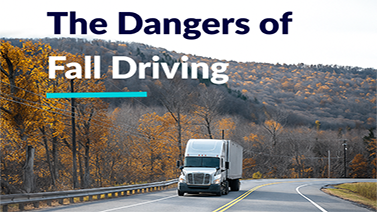FMCSA’s 2024 holiday gift to fleets: CPDP updates redefine crash reviews

The Federal Motor Carrier Safety Administration (FMCSA) has delivered a game-changing update to the Crash Preventability Determination Program (CPDP), giving fleets a powerful tool to improve their safety records. Starting December 1, 2024, the revamped CPDP expands the scope of reviewable crash events and emphasizes the role of video evidence, making it easier for carriers to challenge unfair crash determinations. Here’s what’s new:
Four new crash types added
- Sideswipe by Same-Direction Motorist: When a vehicle strikes a commercial motor vehicle (CMV) from the side while traveling in the same direction
- Private Driveway or Parking Lot Entry Collisions: Incidents where a vehicle entering the road from a driveway or parking lot collides with a CMV.
- Loss of Control by Another Motorist: Crashes caused by a non-CMV driver losing control of their vehicle.
- Crashes Captured on Video: Any crash type can now be reviewed if video evidence clearly proves it was not preventable.
HDVI Takeaway: For HDVI-insured fleets equipped with road-facing dash cameras, these updates represent a significant advantage. Video footage that once couldn’t be submitted now can be used to help carriers challenge crashes more effectively, lowering CSA scores and maintaining competitive insurance rates.
Refinements to Existing Crash Categories
In addition to the new crash types, FMCSA has refined eligibility for several pre-existing categories:
- Alcohol/Drug-Related Crashes: Arrests are no longer required; police-reported indicators of intoxication now suffice.
- Fatigued or Distracted Drivers: Objective evidence, such as dash cam footage, can now replace driver admissions.
- Multi-Vehicle Crashes: Previously excluded, these are now eligible under clarified criteria.
HDVI Takeaway: By prioritizing objective evidence like dash cam footage over verbal admissions, FMCSA underscores the value of data-driven tools. This shift aligns with the broader industry trend of leveraging telematics for decision-making.
Video evidence takes center stage
Perhaps the most impactful update is FMCSA’s recognition of video footage as primary evidence. Dash cameras are no longer optional but essential for effective crash-preventability reviews. Beyond protecting fleets in disputes, dash cams can improve driver training, reduce accidents, and lower insurance premiums.
HDVI Takeaway: Fleet managers without dash cameras are now at a competitive disadvantage. Connected telematics platforms and dash cams are critical for capitalizing on these new rules and achieving better outcomes.
When do the changes take effect?
These updates apply to crashes occurring on or after December 1, 2024. Incidents before this date are ineligible under the new criteria. Fleets that invest in dash cameras now will be prepared to maximize the benefits as soon as the changes roll out.
Final thoughts
FMCSA’s CPDP updates are the holiday gift fleet managers didn’t know they needed. For HDVI-insured fleets, these changes solidify the value of having the right technology and partners. From lowering CSA scores to fairer crash reviews and better insurance rates, fleets equipped with dash cams are positioned to outperform the competition. If you’ve been waiting to invest in dash cameras or partner with an insurer like HDVI, now is the time.
Start 2025 with the tools to improve safety, efficiency, and peace of mind. Happy holidays!


